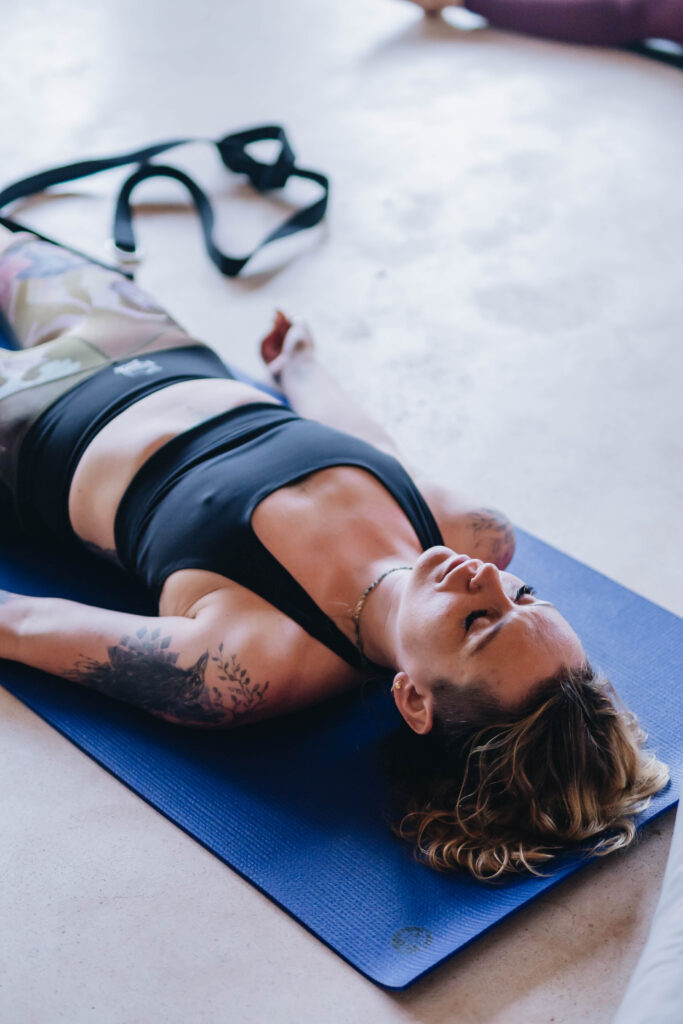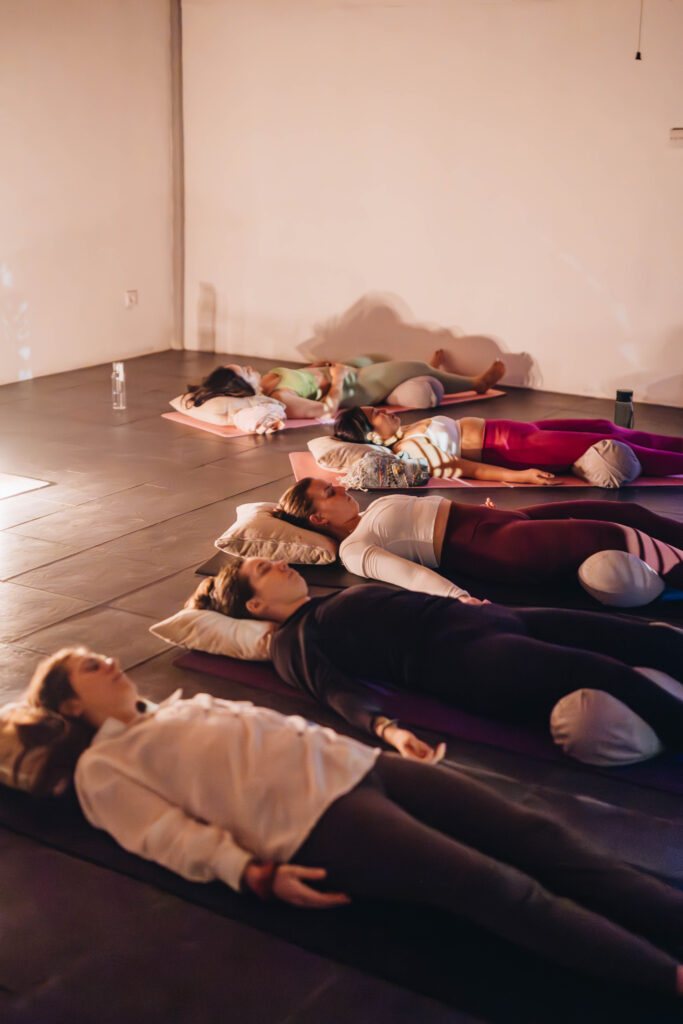
Unlocking Inner Calm: Yoga Nidra—The Secret Weapon for Student Wellbeing
The Seed of Stillness
Sometimes, it feels like your mind is working all over the place, like a runaway train. School, friends, and maybe even a part-time job? Yeah, me too. We’ve all been there, wishing we could just push the pause button for a second, catch a breather, and feel calm again; well, that’s pretty much where Yoga Nidra comes in.
Now, when you hear “yoga,” you might picture twisting around into pretzel shapes, right? But Yoga Nidra? Not really. Think of it as a super-powered nap, but you don’t actually sleep. It’s like having your very own guided tour inside your mind in search of that relaxed, really deep space.
Imagine you lie down all cozy, and someone is quietly talking you through a journey. They tell you to feel your body, to be aware of your breath, and to just let go. It’s hitting the reset button in your mind. We call it “yogic sleep,” but it’s really more like an active rest, awake but relaxed—really, really relaxed.
Why is this important for us, especially here at school? Here, it is about taking care of the whole you: not just your grades but your mind and your well-being, and let’s face it, school is stressful! Exams, presentations, and keeping up with all the past works—it all takes its toll. Yoga Nidra is basically the secret weapon for all that. It calms you down, clears your head, and with a fresh perspective, you are ready to attack tasks ahead.
We’ll go into more detail about how it works and what it can do for you, but for now, just know that it’s a simple, effective way to find a little peace in the midst of a hectic day. Think of it as planting a tiny seed of stillness inside you, a moment of peace that can grow and help you feel more balanced and centered.

Purpose & Sankalpa
Well, you know Yoga Nidra is all about chilling out then! But it’s not really about just flopping down and zoning out. There is a bit more to it; this is where “intention” comes in. You know what it’s like to be on a road trip: you need a destination! Yoga Nidra is a journey, and your intention, or “Sankalpa,” is your destination.
A positive affirmation or intention you plant in your subconscious is just a little seed you want to cultivate in yourself. Why use an intention at all? It turns out that the mind is totally relaxed, and now it’s like fresh soil. This is the perfect time to put suggestions to good use: plant a seed or two.
For all of us students, it’s a biggie. You are anxious about a big test—is there an intention? ” I am calm and confident during my exams. “Or maybe you’re somebody who has trouble trying to focus on class?” I learn easily and effortlessly.” That is how it works! It isn’t really magic that magically makes things happen; rather, it is a kind of gentle coaxing of the mind in the direction of what you want.
Creating your own Sankalpa is pretty straightforward. Just think about something positive you want to cultivate in your life. Just keep it short and to the point; keep it little and in the present, as if it’s there: “I am peaceful,” or “I am focused.” So now, during Yoga Nidra, a teacher or a guide will assist you in settling in and getting really relaxed. But then he will tell you to repeat your Sankalpa a couple of times in order to sow the seed deep in your subconscious.
It’s like whispering a pleasant reminder to yourself while you’re in a particularly receptive condition. And it’s fairly amazing how powerful those simple intents can be. They can help you feel more grounded, confident, and in charge, which is something we all need more of, right?
The Stages
We have already discussed how to get comfortable and set an intention. But what exactly happens during a Yoga Nidra session, you may ask. It is a small trip inside one’s mind. A few stages comprise it.
First, think about your guide as some nice travel agent, guiding you through various “destinations” in your inner realms. The first thing we generally do is called the body scan. It is not doing anything physically; it is instead bringing your attention to each part of your body, one by one. You might hear something like, “Bring your attention to the right thumb, to the right index finger…” etc. It is uncommonly soothing, almost certainly releasing tensions without you even knowing if something is holding onto them.
Next is breath awareness. Observe breath; how it simply arises and subsides in you. You do not have to change it; just take note of it. Like when you witness rising waves on the surface during a calm sea, it is an excellent way to hook your attention into the present moment.
Next could be opposites or sensations or others. It might sound a bit outlandish, but it is interesting. Your guide might invite you to imagine feeling hot, for example, and then cold, or heavy, and then light. It is a play with your senses to take your mind away from its habitual patterns.
We might often move into consciousness visualization. Here, it is imagination playtime. Your guide might ask you to walk through a serene scene of the woods or a quiet beach. It is really like watching a movie in your mind, and most consider it ultra-calming.
The key throughout has been to surrender. What does this mean? It basically means letting up of the need to control anything. If your mind wanders, that’s okay. If you start to drift off, that’s fine. Simply follow the guide and trust the process.
Honestly, it’s like giving oneself permission to simply be. No pressure, no expectations, simply a peaceful exploration of your inner world. It’s an opportunity to escape the noise and discover some inner calm.
Practical Application & Integration
So now we have had a little tour inside the Yoga Nidra. But now how do we apply this at school? All this implies is putting it into practice and using deployable ways of applying it to life.
Suppose you have a big test to take, and you’re feeling that same tension in your stomach. A Yoga Nidra for ten minutes, as opposed to cowboys walking through life? Just little bits of it might be very helpful, even for a few minutes at a time during breaks in class. Just a few minutes then to reset and recharge. It also means that a mental reset would require the push of a refresher button, wouldn’t it? Perhaps it’s just a thought: even before a game or an important presentation,
Yoga Nidra might calm jittery nerves and increase concentration. And we can still take regular breaks instead of keeping people silent during that silent time; we can recharge during that time. And not only at school—you can bring this home, too! Look for a quiet corner that’s not going to be disturbed, and set a guided Yoga Nidra on.
There are countless apps and online resources for Yoga Nidra. That’s like creating a tiny oasis in the comfort of your home. The icing on the cake is, Yoga Nidra acts in such a way that it does not restrict its effects just within the mat but carries those benefits to the world outside.
You will understand that you have become a more patient person, focused on that, and dealing pretty well with stress. Your relationships may get better, for you have now enrolled in being more present and grounded.
Now, I understand some of you may be wondering, “What if I fall asleep?” That’s very typical! This happens. The point is that you are still receiving some sleep, even if you do nod off a little. And what about those thoughts that arise? That’s fine too. Simply acknowledge them and let go. There is no “wrong” way to practice Yoga Nidra.
Finally, it’s about allowing yourself to slow down, be kind to yourself, and find a moment of serenity in the midst of a hectic life. So I invite you to try it. Join us for a session here at school, or choose a tape that you enjoy. You may be amazed by how much it helps. Let us develop a school that cares about everyone’s well-being.

Conclusion & Future Growth
So, that was a mini bit of the roller drive of Yoga Nidra, wasn’t it? We have been discussing that it is not just about relaxation but also about intention-setting while exploring our inner landscape and bringing that into our external life.
So let us recap our learning about Yoga Nidra as a wonderful stress instrument that really helps students to deal with their anxiety, giving improved focus and a general sense of well-being. It is a way of just touching, reaching that calm inside of oneself. And we acknowledge that here at school, and this is where we’re really trying to empower you to flourish in life, not just academically but as a whole human being.
But really, it is just the beginning. Yoga Nidra is a practice, a journey. You can carry on working with and deepening through time. The more you practice, the more you will discover about yourself and those experiences that you will be able to encounter. We are very excited about the opportunity that is unfolding here at school. We are thinking about ways to bring mindfulness and Yoga Nidra into our curriculum in such a way that it is naturally integrated into the routine of our lives.
Ideally, we may have some regular group sessions or workshops where we can learn more about it. And we would like to hear you! What do you think about how we can make Yoga Nidra more accessible and beneficial to everyone? We always welcome your feedback and suggestions.
Finally, it is about creating this space of community in which we are there for each other, take care of our minds and bodies, and learn to find that inner calm that is there all along, waiting for us in our inner being. Because, let’s face it, life can get stressful sometimes—when we know that we have things like Yoga Nidra as a tool with us, that is greatly appreciated.
read also – Breathe Easy, Live Better: The Power of Pranayama , Yoga Teacher Training in Rishikesh ,
200 Hour Yoga Teacher Training Course Bali , Mudras and Their Benefits in Yoga